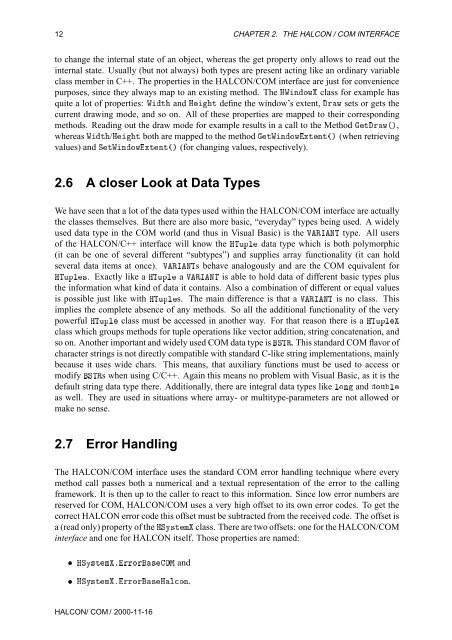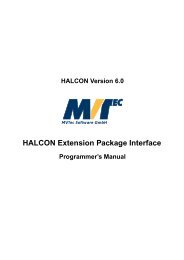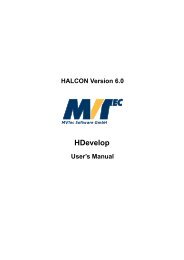HALCON/COM User's Manual
HALCON/COM User's Manual
HALCON/COM User's Manual
Create successful ePaper yourself
Turn your PDF publications into a flip-book with our unique Google optimized e-Paper software.
12 CHAPTER 2. THE <strong>HALCON</strong> / <strong>COM</strong> INTERFACE<br />
to change the internal state of an object, whereas the get property only allows to read out the<br />
internal state. Usually (but not always) both types are present acting like an ordinary variable<br />
class member in C++. The properties in the <strong>HALCON</strong>/<strong>COM</strong> interface are just for convenience<br />
purposes, since they always map to an existing method. The ÀÏÒÓÛ class for example has<br />
quite a lot of properties: ÏØ and ÀØ define the window’s extent, ÖÛ sets or gets the<br />
current drawing mode, and so on. All of these properties are mapped to their corresponding<br />
methods. Reading out the draw mode for example results in a call to the Method ØÖÛ´µ,<br />
whereas ÏØ/ÀØ both are mapped to the method ØÏÒÓÛÜØÒØ´µ (when retrieving<br />
values) and ËØÏÒÓÛÜØÒØ´µ (for changing values, respectively).<br />
2.6 A closer Look at Data Types<br />
We have seen that a lot of the data types used within the <strong>HALCON</strong>/<strong>COM</strong> interface are actually<br />
the classes themselves. But there are also more basic, “everyday” types being used. A widely<br />
used data type in the <strong>COM</strong> world (and thus in Visual Basic) is the ÎÊÁÆÌ type. All users<br />
of the <strong>HALCON</strong>/C++ interface will know the ÀÌÙÔÐ data type which is both polymorphic<br />
(it can be one of several different “subtypes”) and supplies array functionality (it can hold<br />
several data items at once). ÎÊÁÆÌs behave analogously and are the <strong>COM</strong> equivalent for<br />
ÀÌÙÔÐ×. Exactly like a ÀÌÙÔÐ a ÎÊÁÆÌ is able to hold data of different basic types plus<br />
the information what kind of data it contains. Also a combination of different or equal values<br />
is possible just like with ÀÌÙÔÐs. The main difference is that a ÎÊÁÆÌ is no class. This<br />
implies the complete absence of any methods. So all the additional functionality of the very<br />
powerful ÀÌÙÔÐ class must be accessed in another way. For that reason there is a ÀÌÙÔÐ<br />
class which groups methods for tuple operations like vector addition, string concatenation, and<br />
so on. Another important and widely used <strong>COM</strong> data type is ËÌÊ. This standard <strong>COM</strong> flavor of<br />
character strings is not directly compatible with standard C-like string implementations, mainly<br />
because it uses wide chars. This means, that auxiliary functions must be used to access or<br />
modify ËÌÊs when using C/C++. Again this means no problem with Visual Basic, as it is the<br />
default string data type there. Additionally, there are integral data types like ÐÓÒ and ÓÙÐ<br />
as well. They are used in situations where array- or multitype-parameters are not allowed or<br />
make no sense.<br />
2.7 Error Handling<br />
The <strong>HALCON</strong>/<strong>COM</strong> interface uses the standard <strong>COM</strong> error handling technique where every<br />
method call passes both a numerical and a textual representation of the error to the calling<br />
framework. It is then up to the caller to react to this information. Since low error numbers are<br />
reserved for <strong>COM</strong>, <strong>HALCON</strong>/<strong>COM</strong> uses a very high offset to its own error codes. To get the<br />
correct <strong>HALCON</strong> error code this offset must be subtracted from the received code. The offset is<br />
a (read only) property of the ÀËÝ×ØÑ class. There are two offsets: one for the <strong>HALCON</strong>/<strong>COM</strong><br />
interface and one for <strong>HALCON</strong> itself. Those properties are named:<br />
¯ ÀËÝ×ØѺÖÖÓÖ×ÇÅ and<br />
¯ ÀËÝ×ØѺÖÖÓÖ×ÀÐÓÒ.<br />
<strong>HALCON</strong>/ <strong>COM</strong> / 2000-11-16
















